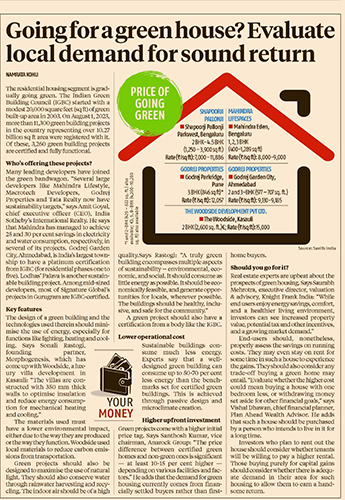The residential housing segment is gradually going green. The Indian Green Building Council (IGBC) started with a modest 20,000 square feet (sq. ft.) of green built-up area in 2003. On August 1, 2023, more than 11,300 green building projects in the country representing over 10.27 billion sq. ft. area were registered with it. Of these, 3,260 green building projects are certified and fully functional.
Who’s offering these projects?
Many leading developers have joined the green bandwagon. “Several large developers like Mahindra Lifestyle, Macrotech Developers, Godrej Properties and Tata Realty now have sustainability targets,” says Amit Goyal, chief executive officer (CEO), India Sotheby’s International Realty.
He says that Mahindra has managed to achieve 25 and 30 per cent savingsin electricity and water consumption, respectively, in several of its projects. Godrej Garden City, Ahmedabad, is India’s largest township to have a platinum certification from IGBC (for residential phases one to five). Lodhas’ Palava is another sustainable building project. Among mid-sized developers, most of Signature Global’s projects in Gurugram are IGBC-certified.
Key features
The design of a green building and the technologies used therein should minimise the use of energy, especially for functions like lighting, heating and cooling. Says Sonali Rastogi, founding partner, Morphogenesis, which has come up with Woodside, a luxury villa development in Kasauli: “The villas are constructed with 350 mm thick walls to optimise insulation and reduce energy consumption for mechanical heating and cooling.”
The materials used must have a lower environmental impact, either due to the way they are produced or the way they function. Woodside used local materials to reduce carbon emissions from transportation.
Green projects should also be designed to maximise the use of natural light. They should also conserve water through rainwater harvesting and recycling. The indoor air should be of a high quality.
Says Rastogi: “A truly green building encompasses multiple aspects of sustainability — environmental, economic, and social. It should consume as little energy as possible. It should be economically feasible, and generate opportunities for locals, wherever possible. The buildings should be healthy, inclusive, and safe for the community.”
A green project should also have a certification from an organisation like the IGBC.
Lower operational cost
Sustainable buildings consume much less energy. Experts say that a well-designed green building can consume up to 50-70 per cent less energy than the benchmarks set for certified green buildings. This is achieved through passive design and microclimate creation.
Higher upfront investment
Green projects come with a higher initial price tag. Says Santhosh Kumar, vice chairman, ANAROCK Group: “The price difference between certified green homes and non-green ones is significant — at least 10-15 per cent higher — depending on various facilities and factors.” He adds that the demand for green housing currently comes from financially settled buyers rather than first-home buyers.
Should you go for it?
Real estate experts are upbeat about the prospects of green housing. Says Saurabh Mehrotra, executive director, valuation & advisory, Knight Frank India: “While end users enjoy energy savings, comfort, and a healthier living environment, investors can see increased property value, potential tax and other incentives, and a growing market demand.”
End-users should, nonetheless, properly assess the savings on running costs. They may even stay on rent for some time in such a house to experience the gains. They should also consider any trade-off buying a green home may entail. “Evaluate whether the higher cost could mean buying a house with one bedroom less, or withdrawing money set aside for other financial goals,” says Vishal Dhawan, chief financial planner, Plan Ahead Wealth Advisor. He adds that such a house should be purchased by a person who intends to live in it for a long time. Those who plan to take a home loan need to do the math even more carefully.
Investors who plan to rent out the house should consider whether tenants will be willing to pay a higher rental. Those buying purely for capital gains should consider whether there is adequate demand in their area for such housing to allow them to earn a handsome return.





